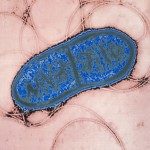About
CRISPR loci and the associated Cas genes are the adaptive immune system of archeae and bacteria. They have the ability to capture pieces of DNA from viruses and other invading genetic elements [1], and can then use this information to cleave foreign DNA sequences through the action of Cas proteins that act as RNA-guided nucleases [2].
The Bikard lab focuses on the many unresolved aspects of CRISPR biology and their application as tools to study and fight pathogenic bacteria. The Cas9 protein, a RNA-guided nuclease from the S. pyogenes CRISPR system, can be used as a tool for genome engineering [3]. The approach relies on the ability to re-program CRISPR specificity through a small RNA, which directs Cas9 to cleave a target genomic locus and promotes the recombination of a homologous template containing a desired mutation. This method allows the easy engineering of any genomic loci in a diversity of bacteria. The catalytic site of Cas9 can also be mutated, giving dCas9 (dead Cas9), and repurposing it as a RNA-guided DNA binding protein [4]. This binding is strong enough to block transcription and can thus be used to easily knock-down any gene in the cell. Transcription activator domains can also be fused to Cas9, which can then be used to activate gene expression. We are now developing a high-throughput assay that will enable to knockdown all genes and all pairs of genes in a bacterial genome, using libraries of guide RNAs to direct dCas9 knockdowns.
Another area of focus is the development of sequence-specific antimicrobials using CRISPR. When directed to cleave the host cell genome, the Cas9 nuclease leads to cell death. Phagemids can be used as vectors to deliver self-targeting CRISPR systems to bacterial populations. The CRISPR can be programmed to kill bacteria carrying antibiotic resistance or virulence genes, leaving the rest of the microbiota intact.
- Heler, R., L.A. Marraffini, and D. Bikard, Adapting to new threats: the generation of memory by CRISPR-Cas immune systems. Mol Microbiol, 2014.
- Sorek, R., C.M. Lawrence, and B. Wiedenheft, CRISPR-mediated adaptive immune systems in bacteria and archaea. Annu Rev Biochem, 2013. 82: p. 237-66.
- Jiang, W., et al., RNA-guided editing of bacterial genomes using CRISPR-Cas systems. Nature biotechnology, 2013. 31(3): p. 233-9.
- Bikard, D., et al., Programmable repression and activation of bacterial gene expression using an engineered CRISPR-Cas system. Nucleic Acids Res, 2013. 41(15): p. 7429-37.

